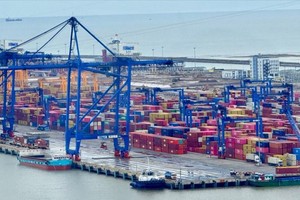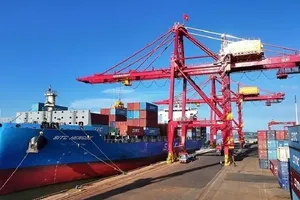 Illustrative image
Illustrative image
While new bad debts incurred until 31 December 2021 were at VND251.3 trillion, from August 15, 2017, to December 31, 2021, CIs have only handled VND380.2 trillion of bad debts. Unresolved bad debts are still at around VND412.7 trillion.
Handling collateral
Resolution 42/2017/QH14 of the National Assembly for handling of bad debts is expected to create an open and wider corridor for the handling of bad debts as well as bring in capital for the economy. However, the progress on this does not really commensurate with the expectations. In reports sent by commercial banks, as well as the State Bank of Vietnam, bad debts settlements under Resolution 42 have achieved positive results. Since some difficulties and problems still exist, it is necessary to have the coordination of relevant ministries and branches to handle problems in seizing collateral assets or resolving disputes according to procedures of court.
It is a fact that although property can be recovered, selling it to recover the debt is very difficult and problematic. Bank for Investment and Development of Vietnam (BIDV) recently announced the auction of debts of two enterprises built under credit contracts, namely, the Bach Giang Construction Trading House Company Limited and the Cao Nguyen (Highland) Trading Construction Company Limited. This is the eighth time this debt auction will take place.
Vietcombank also announced auction of collateral of the Petroleum Design Consultancy Company with starting price at VND270.6 billion. This debt has been on sale many times before but had no successful bidders. In the latest offering, the selling price is at VND340 billion. These are just a few of the many assets of great value with banks that have had unsuccessful bidding auctions, although many have been greatly reduced in price value.
The difficulty in handling of special assets at the present time was predicted many years ago. The reason is partly due to the value of the fixed assets offered for sale not being close to the actual value because of being over-valued in the past. Now, banks include both principal and interest in the selling price, while those collaterals after a long time no longer have the same value as the original.
The other problem arises from the fact that most of the collateral at the banks is in varied forms, with most of it in real estate. In this, there are legal assets that can be bought and sold, but there are also legal assets that cannot be bought and sold. There are also new types of semi-finished real estate that are partially compensated or are under construction, so buyers are also concerned about the next procedures, or of factories having no prospects for future development. Such products have difficulty in stimulating the market demand. Moreover, the supply is far greater, and buyers are not that many.
Rise in new bad debts
Finding a way out of bad debts has been a constant problem for many years, but the above list shows that the banking industry has not yet been able to get rid of the burden of bad debts. Meanwhile, new bad debts are continuing to rise. According to the State Bank of Vietnam, by December 31, 2021, the ratio of bad debts on the balance sheet, debts sold to VAMC, and potential debts turning into bad debts stands at 6.31 percent.
Currently, the Economic Committee of the National Assembly agrees with the proposal of the Government, to extend the application period for all provisions of Resolution 42 until the end of December 31, 2023, including the content in the General Resolution of the third session at the 15th National Assembly. The National Assembly deputies also suggest that there should be specific commitments because otherwise existing bad debts cannot be handled and there is a risk of further rise in more new bad debts.
More worrisome is that in coming time, bad debts will not only come from debts structured due to the impact of the Covid-19 pandemic but also from debts of real estate enterprises through corporate bonds at banks. According to data from SSI Research, in 2021, real estate enterprises issued VND318.2 trillion of corporate bonds, accounting for 44 percent of the total amount of corporate bonds issued, an increase of 66.3 percent compared to 2020. Of these, the number of corporate bonds without collateral or secured partially or whole with shares was at VND172.5 trillion, accounting for 54.2 percent of the issuance in 2021.
From the end of 2021, experts have warned of corporate bonds risks. Until the cancellation of bonds of companies belonging to the Tan Hoang Minh Group, the issuance activity had not slowed down. In the first quarter of 2022, real estate enterprises still led in terms of issuance value with a total volume of VND17.21 trillion, accounting for 43.36 percent of the total issuance value across the country. However, by April, there was no corporate bond issuances by real estate companies.
Many people think that it will be difficult for real estate businesses to continue to raise capital from the corporate bonds market after the above incidents. At the same time, commercial banks have also tightened credit for this sector. The SBV has raised the risk coefficient for real estate loans and has proposed a roadmap to reduce the ratio of short-term capital for medium and long-term loans. This will create a problem for real estate enterprises in the future. According to Asso. Prof. Dr. Truong Quang Thong from the University of Economics in HCMC, many corporate bonds, including in real estate, are held by commercial banks and that number is certainly not small.
In case these enterprises cannot repay the bondholders due to difficulties in raising capital, it would lead to bottlenecks in both liquidity flow and the project itself, hence banks would be strongly affected. In such a perspective, it can be said that the banking industry is looking for a way out of their bad debts situation but is currently still inundated under bad debts and will have to continue to bear this burden for a very long time to come.
Handling collateral
Resolution 42/2017/QH14 of the National Assembly for handling of bad debts is expected to create an open and wider corridor for the handling of bad debts as well as bring in capital for the economy. However, the progress on this does not really commensurate with the expectations. In reports sent by commercial banks, as well as the State Bank of Vietnam, bad debts settlements under Resolution 42 have achieved positive results. Since some difficulties and problems still exist, it is necessary to have the coordination of relevant ministries and branches to handle problems in seizing collateral assets or resolving disputes according to procedures of court.
It is a fact that although property can be recovered, selling it to recover the debt is very difficult and problematic. Bank for Investment and Development of Vietnam (BIDV) recently announced the auction of debts of two enterprises built under credit contracts, namely, the Bach Giang Construction Trading House Company Limited and the Cao Nguyen (Highland) Trading Construction Company Limited. This is the eighth time this debt auction will take place.
Vietcombank also announced auction of collateral of the Petroleum Design Consultancy Company with starting price at VND270.6 billion. This debt has been on sale many times before but had no successful bidders. In the latest offering, the selling price is at VND340 billion. These are just a few of the many assets of great value with banks that have had unsuccessful bidding auctions, although many have been greatly reduced in price value.
The difficulty in handling of special assets at the present time was predicted many years ago. The reason is partly due to the value of the fixed assets offered for sale not being close to the actual value because of being over-valued in the past. Now, banks include both principal and interest in the selling price, while those collaterals after a long time no longer have the same value as the original.
The other problem arises from the fact that most of the collateral at the banks is in varied forms, with most of it in real estate. In this, there are legal assets that can be bought and sold, but there are also legal assets that cannot be bought and sold. There are also new types of semi-finished real estate that are partially compensated or are under construction, so buyers are also concerned about the next procedures, or of factories having no prospects for future development. Such products have difficulty in stimulating the market demand. Moreover, the supply is far greater, and buyers are not that many.
Rise in new bad debts
Finding a way out of bad debts has been a constant problem for many years, but the above list shows that the banking industry has not yet been able to get rid of the burden of bad debts. Meanwhile, new bad debts are continuing to rise. According to the State Bank of Vietnam, by December 31, 2021, the ratio of bad debts on the balance sheet, debts sold to VAMC, and potential debts turning into bad debts stands at 6.31 percent.
Currently, the Economic Committee of the National Assembly agrees with the proposal of the Government, to extend the application period for all provisions of Resolution 42 until the end of December 31, 2023, including the content in the General Resolution of the third session at the 15th National Assembly. The National Assembly deputies also suggest that there should be specific commitments because otherwise existing bad debts cannot be handled and there is a risk of further rise in more new bad debts.
More worrisome is that in coming time, bad debts will not only come from debts structured due to the impact of the Covid-19 pandemic but also from debts of real estate enterprises through corporate bonds at banks. According to data from SSI Research, in 2021, real estate enterprises issued VND318.2 trillion of corporate bonds, accounting for 44 percent of the total amount of corporate bonds issued, an increase of 66.3 percent compared to 2020. Of these, the number of corporate bonds without collateral or secured partially or whole with shares was at VND172.5 trillion, accounting for 54.2 percent of the issuance in 2021.
From the end of 2021, experts have warned of corporate bonds risks. Until the cancellation of bonds of companies belonging to the Tan Hoang Minh Group, the issuance activity had not slowed down. In the first quarter of 2022, real estate enterprises still led in terms of issuance value with a total volume of VND17.21 trillion, accounting for 43.36 percent of the total issuance value across the country. However, by April, there was no corporate bond issuances by real estate companies.
Many people think that it will be difficult for real estate businesses to continue to raise capital from the corporate bonds market after the above incidents. At the same time, commercial banks have also tightened credit for this sector. The SBV has raised the risk coefficient for real estate loans and has proposed a roadmap to reduce the ratio of short-term capital for medium and long-term loans. This will create a problem for real estate enterprises in the future. According to Asso. Prof. Dr. Truong Quang Thong from the University of Economics in HCMC, many corporate bonds, including in real estate, are held by commercial banks and that number is certainly not small.
In case these enterprises cannot repay the bondholders due to difficulties in raising capital, it would lead to bottlenecks in both liquidity flow and the project itself, hence banks would be strongly affected. In such a perspective, it can be said that the banking industry is looking for a way out of their bad debts situation but is currently still inundated under bad debts and will have to continue to bear this burden for a very long time to come.
























